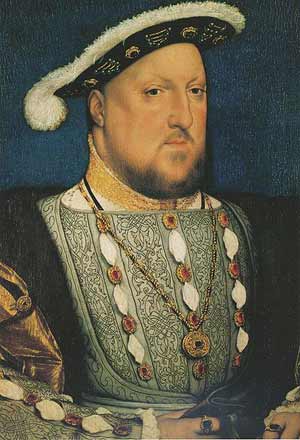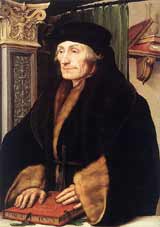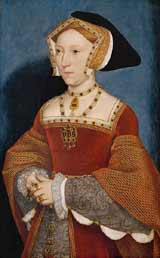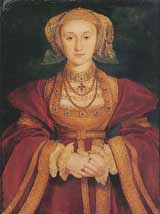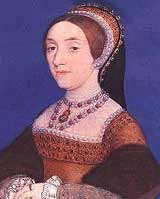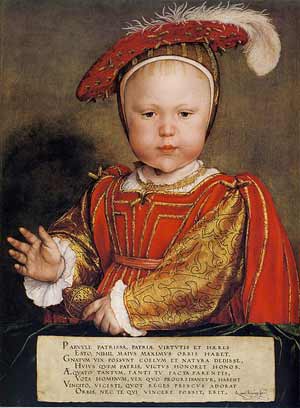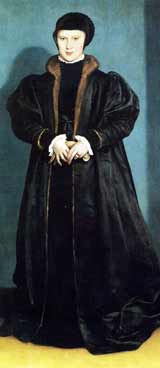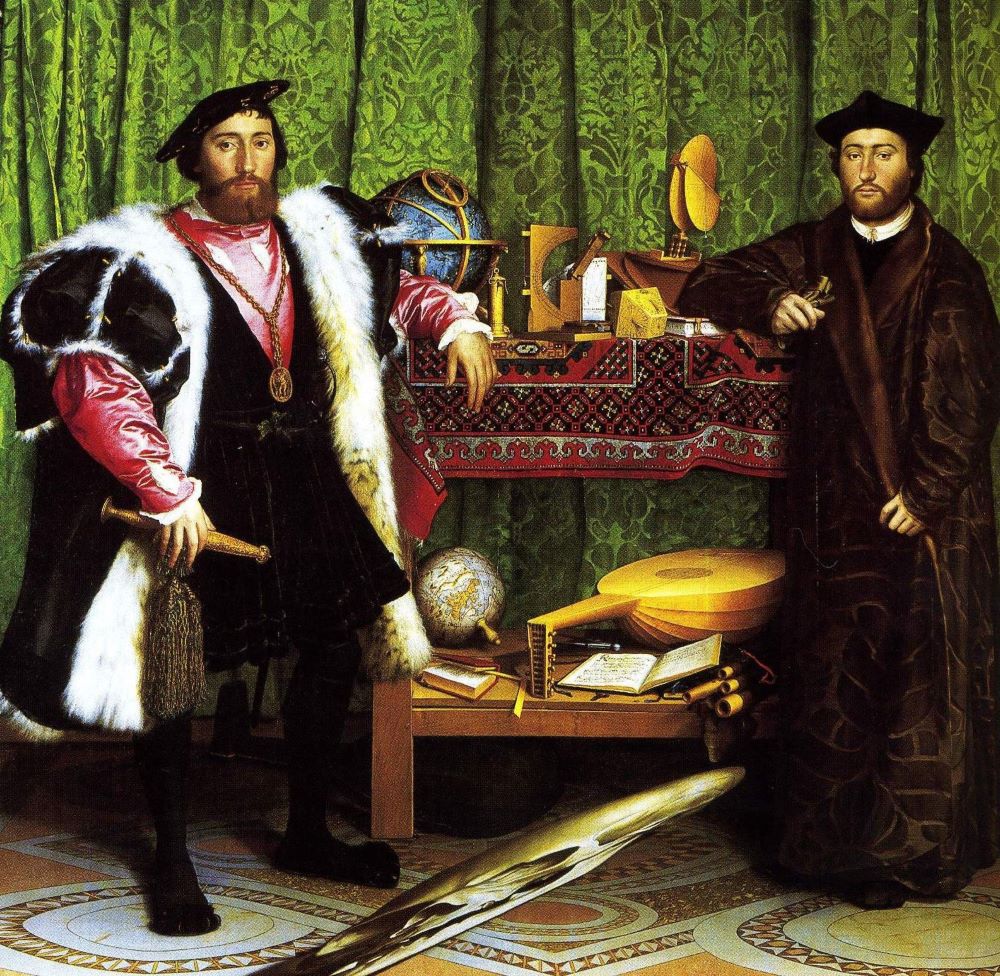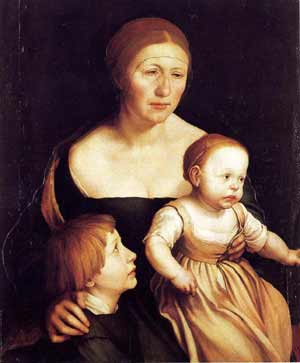Hans Holbein.
Court Painter to England's Henry VIII.
Hans Holbein was born in 1497 in the German city of Augsburg close to the Bavarian border. He was the son of the artist Hans Holbein the Elder and studied under his father before going to Basle with his brother Ambrosius as an apprentice to the painter Hans Herbst. After a brief period working in Lucerne and Zurich, in 1519 he returned to settle in Basle and married Elsbeth Schmid a widow with an infant son.
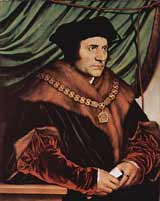 Thomas More. (w)
Thomas More. (w)In Basle, the artist ran a busy workshop and established a glowing reputation in the city.
He completed religious works at this time but was also involved in portraiture, his painting of the Dutch Humanist Erasmus established his reputation. Holbein travelled to England in 1526 and moved in the circles dominated by Thomas More who was a friend of Erasmus. He remained in England for two years, in the period just before the Reformation when More's star still shone brightly at the English Court.
The artist returned to Basle in 1528 where he remained for four years, his purchase of a house in St Johanns-Vorstadt highlights his growing self-confidence in his artistic ability.
Hans Holbein at the Tudor Court.
Holbein's fame is forever linked to the English court of King Henry VIII. His portraits during the English Reformation provide an insight into the characters who dominated this famous and dangerous period of 16th-century history.
In 1532, when Holbein returned to England for the second time, the political landscape was about to undergo a radical change of direction. King Henry was preparing to have his marriage to Catherine of Aragon annulled and replace her with his mistress, Anne Boleyn. This was opposed by the Pope setting in motion a chain of events leading to England's eventual split from Papal supremacy.
The artist seems to have negotiated the political storm, on this second visit he was introduced at court under the patronage of Thomas Cromwell and the Boleyn family. Thomas More, Holbein's host on his first visit to England, was in disgrace for opposing the Kings marriage to Anne Boleyn, he was executed in 1535. Anne Boleyn was herself executed for high treason, incest, and adultery in May 1536.
Personal Opinion: -
I wonder did the artist realise that he was painting a mass-murderer? Henry in all his fine clothes and glittering jewellery gives us just the slightest hint of a sneer. Is this an indication of his contempt for lesser mortals? The King stares out from the pages of history, a cold stare, safe in the knowledge of his God-like all consuming and absolute power.
Eleven days after the execution of Anne Boleyn Henry married his third wife Jane Seymour. Jane was the only one of Henry's wives to bear him a son, Edward. Holbein has produced this charming portrait of the young prince magnificently clothed in royal finery. The attention to detail is superb, sadly Jane Seymour died on 24th October 1537 less than two weeks after Edward's birth.
One of Holbein's most famous paintings is the Ambassadors. The work is a double portrait of the diplomats Jean de Dinteville (on your left) and Georges de Selve, their mission included diplomatic proposals regarding the Kings marriage to Anne Boleyn. The finely painted details within the work contain many symbolic images relating to that mission.
The lute with a broken string, suggesting disagreement; the open book is a text by Luther, indicating some sympathy with reform. The most incredible image is of the distorted skull in the foreground. It rises from the floor only morphing into its skull-like shape when viewed from a very acute angle, side on, (anamorphosis perspective) it's prominence within the painting suggesting a Memento mori -remember you must die- a reminder that we are all mortal.
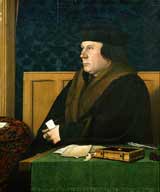 Thomas Cromwell c.1532 (w)
Thomas Cromwell c.1532 (w)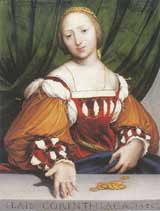 Lais of Corinth. c, 1526 (w)
Lais of Corinth. c, 1526 (w)Holbein travelled to Brussels charged with making a portrait of Christina of Denmark who was touted as a potential wife for the widowed King Henry. His picture of Christina was well received but Henry eventually married Anne of Cleaves (his fourth wife), the artist painted Anne's portrait in 1538. On the arrest and execution of Thomas Cromwell on 28 July 1540, the artist had lost his greatest patron. He completed many commissions from private patrons such as the community of German merchants in London.
Holbein also painted some fine miniatures and a portrait of Anthony Denny, a prominent member of the Privy chamber, who gained favour in the English court after the execution of Henry's fifth wife, Catherine Howard. The King married for the sixth and final time on 12 July 1543 to, the twice-wed, Catherine Parr.
The artist spent a large part of his career separated from his wife and children who remained in Basel during his English period. It is reported that in England he had several affairs producing at least two children.
Personal Opinion: -
This family portrait displays a strange sadness in the faces of his sitters.
Elsbeth, the artist's wife, appears drawn and weary, the children look fearful, almost reminiscent of a deathbed scene, it is in stark contrast to the confidence displayed by the characters in Holbein's paintings from the English court.
Hans Holbein was an artist in the traditional Flemish style, he was influenced by the Gothic teachings of his father Hans Holbein the Elder. He did display some of the Italian styles of Leonardo da Vinci in his painting the Lais of Corinth using Leonardo's sfumato to blend the skin tones. The artist made his will on 7th October 1543, he died from an infection soon afterwards at the age of 45.
- Home
- Hans Holbein
